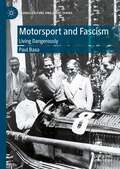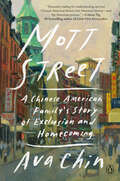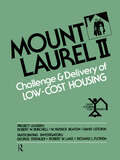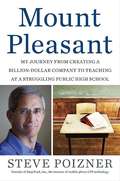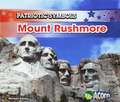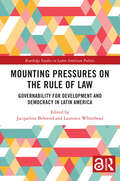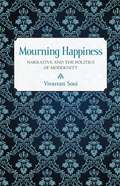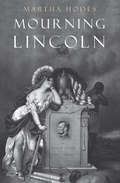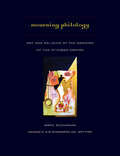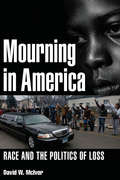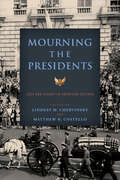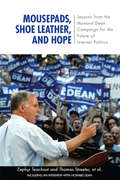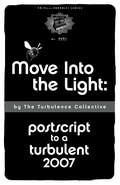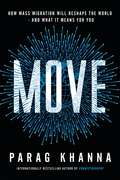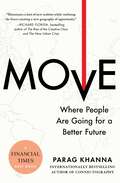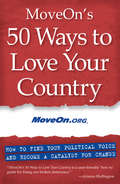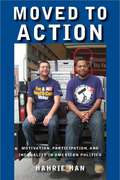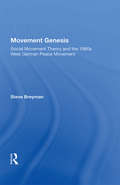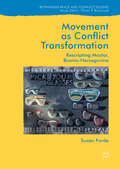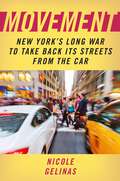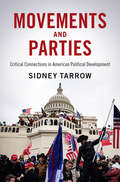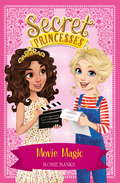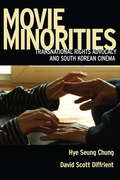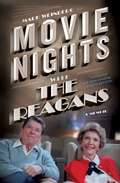- Table View
- List View
Motorsport and Fascism: Living Dangerously (Global Culture and Sport Series)
by Paul BaxaThis book is the first English-language study of motorsport and Italian Fascism, arguing that a synergy existed between motor racing and Fascism that did not exist with other sports. Motorsport was able to bring together the two dominant, and often opposed, cultural roots of Fascism, the Futurism of F. T. Marinetti, and the Decadence associated with Gabriele D’Annunzio. The book traces this cultural convergence through a topical study of motorsport in the 1920s and 1930s placing it in the context of the history of sport under Mussolini’s regime. Chapters discuss the centrality of speed and death in Fascist culture, the attempt to transform Rome into a motorsport capital, the architectural and ideological function of the Monza and Tripoli and autodromes, and two chapters on the importance of the Mille Miglia, a genuine Fascist artefact that became one of the most legendary motor races of all time.
Mott Street: A Chinese American Family's Story of Exclusion and Homecoming
by Ava Chin&“Essential reading for understanding not just Chinese American history but American history—and the American present.&” —Celeste Ng, #1 bestselling author of Little Fires Everywhere* TIME 100 Must-Read Books of 2023 * San Francisco Chronicle's Favorite Nonfiction * Kirkus Best Nonfiction of 2023 * Library Journal Best Memoir and Biography of 2023 * One of Elle's Best Memoirs of 2023 (So Far) * An ALA Notable Book *&“The Angela&’s Ashes for Chinese Americans.&” —Miwa Messer, Poured Over podcastAs the only child of a single mother in Queens, Ava Chin found her family&’s origins to be shrouded in mystery. She had never met her father, and her grandparents&’ stories didn&’t match the history she read at school. Mott Street traces Chin&’s quest to understand her Chinese American family&’s story. Over decades of painstaking research, she finds not only her father but also the building that provided a refuge for them all.Breaking the silence surrounding her family&’s past meant confronting the Chinese Exclusion Act of 1882—the first federal law to restrict immigration by race and nationality, barring Chinese immigrants from citizenship for six decades. Chin traces the story of the pioneering family members who emigrated from the Pearl River Delta, crossing an ocean to make their way in the American West of the mid-nineteenth century. She tells of their backbreaking work on the transcontinental railroad and of the brutal racism of frontier towns, then follows their paths to New York City.In New York&’s Chinatown she discovers a single building on Mott Street where so many of her ancestors would live, begin families, and craft new identities. She follows the men and women who became merchants, &“paper son&” refugees, activists, and heads of the Chinese tong, piecing together how they bore and resisted the weight of the Exclusion laws. She soon realizes that exclusion is not simply a political condition but also a personal one.Gorgeously written, deeply researched, and tremendously resonant, Mott Street uncovers a legacy of exclusion and resilience that speaks to the American experience, past and present.
Mount Laurel II
by Richard L. Florida David Listokin Robert W. Lake Robert W. Burchell George Sternlieb W. Patrick BeatonMount Laurel II is a historic state supreme court decision which mandates that all new residential development include housing for low- and moderate-income families. This study provides a rational approach to low-cost housing. Methods for defining housing market areas are given, as well as demand and supply projection techniques. Housing cost reduction alternatives and allocation approaches are detailed. It elaborates step-by-step methodologies with operational baselines, data framework, and alternative approaches.The Potential of Zoning and Subdivision Controls, What Housing is Affordable - And by Whom, Fair Share Allocation Procedures.
Mount Pleasant: My Journey from Creating a Billion-dollar Company to Teaching at a Struggling Public High School
by Steve PoiznerA Silicon Valley entrepreneur takes on the challenge of a lifetime: teaching in one of California's toughest high schools. Entrepreneur Steve Poizner has run a billion dollar company, but the greatest challenge of his life was the year he spent teaching twelfth graders at San Jose's Mt. Pleasant High School. On many days, like the one when a student's boyfriend was arrested for bank robbery, his managerial and entrepreneurial skills seemed irrelevant. But on others, they helped him demonstrate how exciting it is to learn. Playing Jeopardy with the class and inviting speakers into the classroom, Poizner motivated his students by expanding their horizons far beyond their high school's walls. Steve Poizner is currently a candidate for governor of California and on the verge of becoming a household name. But this is a memoir of a riveting personal journey, not a point-by-point account of his vision for his state. Poizner writes, "Often I came to ask myself one question: What exactly are you doing here? As it turns out, I was receiving one hell of an education. " Mt Pleasant is ultimately a success story, as Poizner wins Rookie Teacher of the Year honors and, more important, ensures that all his students graduate.
Mount Rushmore (Patriotic Symbols Ser.)
by Nancy HarrisProvides a general overview of what Mount Rushmore means as a symbol.
Mount Vernon (Cornerstones of Freedom)
by Mary CollinsDescribes the history of the Virginia estate that was home to this country's first president and is now maintained as a national landmark.
Mounting Pressures on the Rule of Law: Governability for Development and Democracy in Latin America (Routledge Studies in Latin American Politics)
by Edited by Jacqueline Behrend and Laurence WhiteheadThis important book offers an original perspective on the rule of law, development, and democracy in Latin America, establishing a new approach in recognizing the realities of political economy as opposed to merely structural and institutional factors.With contributions from an international team of experts, the book outlines the main challenges that have arisen in the pursuit of a developmental agenda in the region, including subnational variations, state capture by local elites, variations in state capacity, border divergence from centrally designed perspectives, environmental conflicts, uneven access to justice and the role of international organizations. In doing so, the book explores the democratic and developmental implications of conflicts over the rule of law and its application, uneven enforcement, and state capture.Whether a reference tool for the seasoned scholar, a guide aiding practitioner's individual expertise or an introduction to students interested in the complex intersections between the rule of law, development and democracy, this book is a must-have for any library.
Mourning Happiness: Narrative and the Politics of Modernity
by Vivasvan SoniFor many eighteenth-century thinkers, happiness was a revolutionary new idea filled with the promise of the Enlightenment. However, Vivasvan Soni argues that the period fails to establish the importance of happiness as a guiding idea for human practice, generating our modern sentimental idea of happiness. Mourning Happiness shows how the eighteenth century's very obsession with happiness culminates in the political obsolescence of the idea. Soni explains that this puzzling phenomenon can only be comprehended by studying a structural transformation of the idea of happiness at the level of narrative form. Happiness is stripped of its ethical and political content, Soni demonstrates, when its intimate relation to narrative is destroyed. This occurs, paradoxically, in some of the most characteristic narratives of the period: eighteenth-century novels including Pamela, The Vicar of Wakefield, and Julie; the pervasive sentimentalism of the time; Kant's ethics; and the political thought of Rousseau and Jefferson. For Soni, the classical Greek idea of happiness epitomized by Solon's proverb "Call no man happy until he is dead" opens the way to imagining a properly secular conception of happiness, one that respects human finitude and mortality. By analyzing the story of Solon's encounter with Croesus, Attic funeral orations, Greek tragedy, and Aristotle's ethics, Soni explains what it means to think, rather than feel, a happiness available for public judgment, rooted in narrative, unimaginable without a relationship to community, and irreducible to an emotional state. Such an ideal, Soni concludes, would allow for a radical reenvisioning of a politics that takes happiness seriously and responds to our highest aspirations rather than merely keeping our basest motivations in check.
Mourning Lincoln
by Martha HodesA historian examines how everyday people reacted to the president&’s assassination in this &“highly original, lucidly written book&” (James M. McPherson, author of Battle Cry of Freedom). The news of Abraham Lincoln&’s assassination on April 15, 1865, just days after Confederate surrender, astounded a war-weary nation. Massive crowds turned out for services and ceremonies. Countless expressions of grief and dismay were printed in newspapers and preached in sermons. Public responses to the assassination have been well chronicled, but this book is the first to delve into the personal and intimate responses of everyday people—northerners and southerners, soldiers and civilians, black people and white, men and women, rich and poor. Exploring diaries, letters, and other personal writings penned during the spring and summer of 1865, historian Martha Hodes captures the full range of reactions to the president&’s death—far more diverse than public expressions would suggest. She tells a story of shock, glee, sorrow, anger, blame, and fear. &“&’Tis the saddest day in our history,&” wrote a mournful man. It was &“an electric shock to my soul,&” wrote a woman who had escaped from slavery. &“Glorious News!&” a Lincoln enemy exulted, while for the black soldiers of the Fifty-Fourth Massachusetts, it was all &“too overwhelming, too lamentable, too distressing&” to absorb. Longlisted for the National Book Award, Mourning Lincoln brings to life a key moment of national uncertainty and confusion, when competing visions of America&’s future proved irreconcilable and hopes for racial justice in the aftermath of the Civil War slipped from the nation&’s grasp. Hodes masterfully explores the tragedy of Lincoln&’s assassination in human terms—terms that continue to stagger and rivet us today.
Mourning Philology: Art and Religion at the Margins of the Ottoman Empire
by Marc Nichanian“Pagan life seduces me a little more with each passing day. If it were possible today, I would change my religion and would joyfully embrace poetic paganism,” wrote the Armenian poet Daniel Varuzhan in 1908. During the seven years that remained in his life, he wrote largely in this “pagan” vein. If it was an artistic endeavour, why then should art be defined in reference to religion? And which religion precisely? Was Varuzhan echoing Schelling’s Philosophy of Art?Mourning Philology draws on Varuzhan and his work to present a history of the national imagination, which is also a history of national philology, as a reaction to the two main philological inventions of the nineteenth century: mythological religion and the native. In its first part, the book thus gives an account of the successive stages of orientalist philology. The last episode in this story of national emergence took place in 1914 in Constantinople, when the literary journal Mehyan gathered around Varuzhan the great names to come of Armenian literature in the diaspora
Mourning in America: Race and the Politics of Loss
by David W. McivorRecent years have brought public mourning to the heart of American politics, as exemplified by the spread and power of the Black Lives Matter movement, which has gained force through its identification of pervasive social injustices with individual losses. The deaths of Sandra Bland, Michael Brown, Freddie Gray, Trayvon Martin, Tamir Rice, Walter Scott, and so many others have brought private grief into the public sphere. The rhetoric and iconography of mourning has been noteworthy in Black Lives Matter protests, but David W. McIvor believes that we have paid too little attention to the nature of social mourning—its relationship to private grief, its practices, and its pathologies and democratic possibilities.In Mourning in America, McIvor addresses significant and urgent questions about how citizens can mourn traumatic events and enduring injustices in their communities. McIvor offers a framework for analyzing the politics of mourning, drawing from psychoanalysis, Greek tragedy, and scholarly discourses on truth and reconciliation. Mourning in America connects these literatures to ongoing activism surrounding racial injustice, and it contextualizes Black Lives Matter in the broader politics of grief and recognition. McIvor also examines recent, grassroots-organized truth and reconciliation processes such as the Greensboro Truth and Reconciliation Commission (2004–2006), which provided a public examination of the Greensboro Massacre of 1979—a deadly incident involving local members of the Communist Workers Party and the Ku Klux Klan.
Mourning the Presidents: Loss and Legacy in American Culture (Miller Center Studies on the Presidency)
by Lindsay M. Chervinsky Matthew R. CostelloThe death of a chief executive, regardless of the circumstances—sudden or expected, still in office or decades later—is always a moment of reckoning and reflection. Mourning the Presidents brings together renowned and emerging scholars to examine how different generations and communities of Americans have eulogized and remembered US presidents since George Washington’s death in 1799. Over twelve individually illuminating chapters, this volume offers a unique approach to understanding American culture and politics by uncovering parallels between different generations of mourners, highlighting distinct experiences, and examining what presidential deaths can tell us about societal fissures at various critical points in the nation’s history, right up to the present moment.
Mousepads, Shoe Leather, and Hope: Lessons from the Howard Dean Campaign for the Future of Internet Politics (Media and Power)
by Thomas Streeter Zephyr TeachoutHoward Dean's campaign for president changed the way in which campaigns are run today. With an unlikely collection of highly talented and motivated staffers drawn from a variety of backgrounds, the Dean campaign transformed the way in which money was raised and supporters galvanized by using the Internet. Surprisingly, many of the campaign staff members were neither computer whizzes nor practiced political operatives, even though that is how some of them are identified today. This book allows key individuals in the campaign the chance to tell their stories with an eye to documenting the Internet campaign revolution and providing lessons to future campaigns. Howard Dean's inspirational statement of what it took for his campaign to get as far as it did-"mousepads, shoe leather, and hope"-holds great wisdom for anyone campaigning today, especially the 2008 presidential candidates.
Move into the Light: Postscript to a Turbulent 2007 (PM Pamphlet)
by Turbulence CollectiveWhether it's the G8 summit at Heiligendamm or experiments in Latin America, the politics of climate change or uprisings in the French banlieues, questions of visibility and illumination crop up again and again. But our experiences create their own luminosity, and their own areas of darkness. How can we overcome our night-blindness once we move beyond the familiar?
Move: How Mass Migration Will Reshape the World – and What It Means for You
by Parag KhannaWhere will you live in 2030? Where will your children settle in 2040? What will the map of humanity look like in 2050?In the 60,000 years since people began colonising the continents, a recurring feature of human civilisation has been mobility - the constant search for resources and stability. Seismic global events - wars and genocides, revolutions and pandemics - have only accelerated the process. The map of humanity isn't settled, not now, not ever.As climate change tips toward full-blown crisis, economies collapse, governments destabilise and technology disrupts, we're entering a new age of mass migrations - one that will scatter both the dispossessed and the well-off. Which areas will people abandon and where will they resettle? Which countries will accept or reject them? As today's world population, which includes four billion restless youth, votes with their feet, what map of human geography will emerge?Here global strategy advisor Parag Khanna provides an illuminating and authoritative vision of the next phase of human civilisation - one that is both mobile and sustainable. As the book explores, in the years ahead people will move to where the resources are and technologies will flow to the people who need them, returning us to our nomadic roots while building more secure habitats. Move is a fascinating look at the deep trends that are shaping the most likely scenarios for the future. Most importantly, it guides each of us as we determine our optimal location on humanity's ever-changing map.
Move: The Forces Uprooting Us
by Parag KhannaA compelling look at the powerful global forces that will cause billions of us to move geographically over the next decades, ushering in an era of radical change. In the 60,000 years since people began colonizing the continents, a recurring feature of human civilization has been mobility—the ever-constant search for resources and stability. Seismic global events—wars and genocides, revolutions and pandemics—have only accelerated the process. The map of humanity isn&’t settled—not now, not ever. As climate change tips toward full-blown crisis, economies collapse, governments destabilize, and technology disrupts, we&’re entering a new age of mass migrations—one that will scatter both the dispossessed and the well-off. Which areas will people abandon and where will they resettle? Which countries will accept or reject them? As today&’s world population, which includes four billion restless youth, votes with their feet, what map of human geography will emerge? In Move, celebrated futurist Parag Khanna provides an illuminating and authoritative vision of the next phase of human civilization—one that is both mobile and sustainable. As the book explores, in the years ahead people will move people to where the resources are and technologies will flow to the people who need them, returning us to our nomadic roots while building more secure habitats. Move is a fascinating look at the deep trends that are shaping the most likely scenarios for the future. Most important, it guides each of us as we determine our optimal location on humanity&’s ever-changing map.
MoveOn's 50 Ways to Love Your Country
by Moveon. OrgWith more than 2 million members, MoveOn is at the cutting edge of a new model for political activism. In their first-ever book, they take their message offline with MoveOn's 50 Ways to Love Your Country: How to Find Your Political Voice and Become a Catalyst for Change, in an effort to jumpstart an even broader civic dialogue and inspire all to become involved in our political process. With introductions by Al Gore, Nancy Pelosi, Gail Sheehy, David Fenton, and the MoveOn staff, MoveOn's 50 Ways to Love Your Country is a political call-to-action guide that includes 50 essays from MoveOn members across the country. Each essay is a compelling personal story with action items and resources. Simple ideas are illuminated, such as "Vote, No Matter What," about a dying man's wish to cast a ballot, as are more dynamic actions, such as "Start a Petition," which chronicles a couple's quest to protect endangered wolves in Alaska. For those who feel powerless or overwhelmed, angry or apathetic -- or just want to do something, but don't know how -- MoveOn's 50 Ways to Love Your Country answers the question so many people are asking, "What can I do?"
Moved to Action
by Hahrie C. HanHan (political science, Wellesley College and health policy, Harvard U. ) investigates how people without many educational, financial, and civic resources become engaged to participate in politics. Many studies show the most people who participate in politics are interested in it, have the resources, and are asked; she looks at people who have none of that, but dive in anyway. She covers the challenge of political equality, theoretical foundations, issue publics and the distribution of political motivation, an empirical look at issue publics and participation, pathways to participation, and looking ahead. Her case studies come from a wide range of issues, organizations, and campaigns. Annotation c2010 Book News, Inc. , Portland, OR (booknews. com)
Movement Genesis: Social Movement Theory And The West German Peace Movement
by Steven BreymanTo make sense of the rise and fall, origins and nature, of the 1980s West German peace movement requires work that is part political sociology and part social movement theory building. An analysis of the peace movement's organizations, leadership, strategy, goals, tactics, and mobilization comprises the political sociology part of this study. To un
Movement as Conflict Transformation: Rescripting Mostar, Bosnia-Herzegovina (Rethinking Peace and Conflict Studies)
by Susan FordeThis book presents narratives of the social use of space in the divided city of Mostar, Bosnia-Herzegovina. Through the narratives of movement in the city, the work demonstrates how residents engage informally with conflict transformation through new movement and use of spaces. This book will appeal across the social sciences, and in particular to students, academics, and researchers in the fields of peace and conflict studies, political sociology, and human geography.
Movement: New York's Long War to Take Back Its Streets from the Car
by Nicole GelinasWINNER, 2025 GOTHAM BOOK PRIZEInsideHook: The 10 Books You Should Be Reading This NovemberA gripping account of how the automobile has failed NYC and how mass transit and a revitalized streetscape are vital to its post-pandemic recoveryIn 1969, as all students of New York City history think they have learned, master builder Robert Moses lost his long battle to urbanist Jane Jacobs over his planned Lower Manhattan Expressway. The ten-lane elevated expressway would have sliced across SoHo and Little Italy, demolishing historic buildings, and displacing thousands of families and businesses. Jacobs and her neighbors defeated Moses, and as a result, New York became the only major American city with no interstate highway running through its core. Like many global cities, though, New York had spent fifty years during the first half of the twentieth century trying and failing to tame its heavily populated landscape to fit the private automobile. New York has now spent more than fifty years trying to undo those mistakes, wresting back city space for people, not cars.Movement: New York’s Long War to Take Back Its Streets from the Car chronicles the earlier, less-known battles that preceded the cancellation of the Lower Manhattan Expressway: Jacobs became an example for generations of urban planners, but whose example did Jacobs emulate in an earlier victory that saved Washington Square Park? Moses may serve handily as New York’s uber-villain now, but who, before him, was responsible for destroying a critical part of New York’s transit system?A well respected urban writer who has focused on New York’s transportation system for more than a decade, author Nicole Gelinas resumes the story where Robert Caro’s landmark The Power Broker ended. Movement explores how, in the half-century leading up to the COVID- 19 pandemic, New York’s re-embracement of its mass-transit system and a livable streetscape helped save the city. Gelinas tackles the 1970s environmental movement, the 1980s rebuilding of the subways, and more contemporary battles, from Mayor Bloomberg's push for more pedestrian plazas and bike lanes in the early 2000s, to transportation advocates' protests to prevent traffic deaths in the Mayor de Blasio era of the 2010s, to how New York’s stewardship of its streets and subways have played a critical role during the 2020 pandemic and subsequent recovery. Introducing a cast of transportation heroes to rival Jane Jacobs (Shirley Hayes, Hazel Henderson, Richard Ravitch, Nilka Martell) and puncturing the myth of Moses as New York’s anti-hero, Movement explores how New York City has helped redefine what it means to be a global city: not a place that is easy to drive through, but a place where people can take transit, walk, and bike to work, to school, or just for fun.
Movements and Parties: Critical Connections in American Political Development (Cambridge Studies in Contentious Politics)
by Sidney TarrowHow do social movements intersect with the agendas of mainstream political parties? When they are integrated with parties, are they coopted? Or are they more radically transformative? Examining major episodes of contention in American politics – from the Civil War era to the women's rights and civil rights movements to the Tea Party and Trumpism today – Sidney Tarrow tackles these questions and provides a new account of how the interactions between movements and parties have been transformed over the course of American history. He shows that the relationships between movements and parties have been central to American democratization – at times expanding it and at times threatening its future. Today, movement politics have become more widespread as the parties have become weaker. The future of American democracy hangs in the balance.
Movie Magic: Book 16 (Secret Princesses #16)
by Rosie BanksA magical new series where best friends become Secret Princesses!Best friends Charlotte and Mia can't bear it when Charlotte's family moves far away. But when they become trainee Secret Princesses they begin an amazing adventure together - and they can see each other whenever they like!Once in a blue moon, a tiara shaped constellation forms high in the sky above Wishing Star Palace. The four girls that make a wish on these special stars get their wishes granted by the Secret Princesses ... but Princess Poison is determined that this year the wishes won't come true ...Have you read all four books in series four: The Moonstone Collection?
Movie Minorities: Transnational Rights Advocacy and South Korean Cinema
by David Scott Diffrient Hye Seung ChungRights advocacy has become a prominent facet of South Korea’s increasingly transnational motion picture output, especially following the 1998 presidential inauguration of Kim Dae-jung, a former political prisoner and victim of human rights abuses who received the Nobel Peace Prize in 2000. Today it is not unusual to see a big-budget production about the pursuit of social justice or the protection of civil liberties contending for the top spot at the box office. With that cultural shift has come a diversification of film subjects, which range from undocumented workers’ rights to the sexual harassment experienced by women to high-school bullying to the struggles among people with disabilities to gain inclusion within a society that has transformed significantly since winning democratic freedoms three decades ago. Combining in-depth textual analyses of films such as Bleak Night, Okja, Planet of Snail, Repatriation, and Silenced with broader historical contextualization, Movie Minorities offers the first English-language study of South Korean cinema’s role in helping to galvanize activist social movements across several identity-based categories.
Movie Nights with the Reagans: A Memoir
by Mark WeinbergFormer special advisor and press secretary to President Ronald Reagan shares an intimate, behind-the-scenes look inside the Reagan presidency—told through the movies they watched together every week at Camp David.What did President Ronald Reagan think of Rocky IV? How did the Matthew Broderick film WarGames inform America’s missile defense system? What Michael J. Fox movie made such an impression on President Reagan that he felt compelled to mention it in a speech to the Joint Session of Congress? Over the course of eight years, Mark Weinberg travelled to Camp David each weekend with Ronald and Nancy Reagan. He was one of a few select members invited into the Aspen Lodge, where the First Family screened both contemporary and classic movies on Friday and Saturday nights. They watched movies in times of triumph, such as the aftermath of Reagan’s 1984 landslide, and after moments of tragedy, such as the explosion of the Challenger and the shooting of the President and Press Secretary Jim Brady. Weinberg’s unparalleled access offers a rare glimpse of the Reagans—unscripted, relaxed, unburdened by the world, with no cameras in sight. Each chapter discusses a legendary film, what the Reagans thought of it, and provides warm anecdotes and untold stories about his family and the administration. From Reagan’s pranks on the Secret Service to his thoughts on the parallels between Hollywood and Washington, Weinberg paints a full picture of the president The New Yorker once famously dubbed “The Unknowable.” Movie Nights with the Reagans is a nostalgic journey through the 1980s and its most iconic films, seen through the eyes of one of Hollywood’s former stars: one who was simultaneously transforming the Republican Party, the American economy, and the course of the Cold War.
